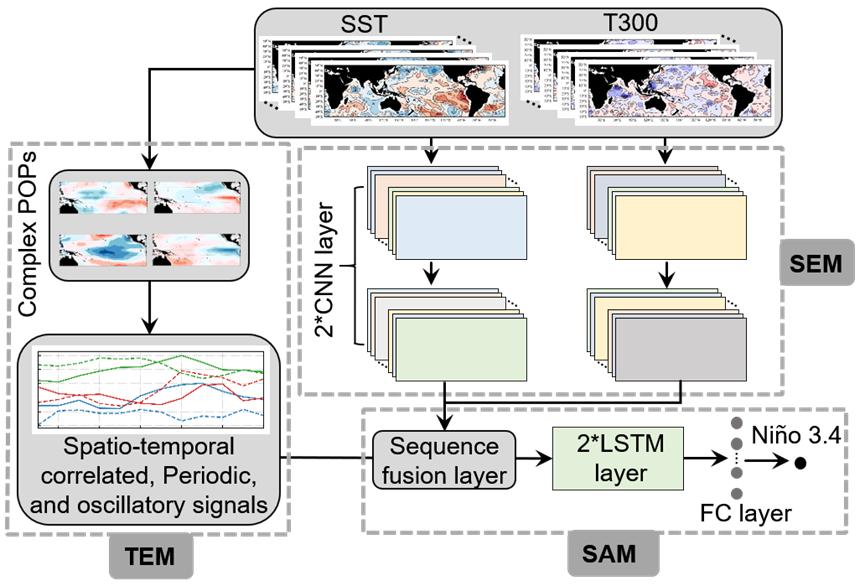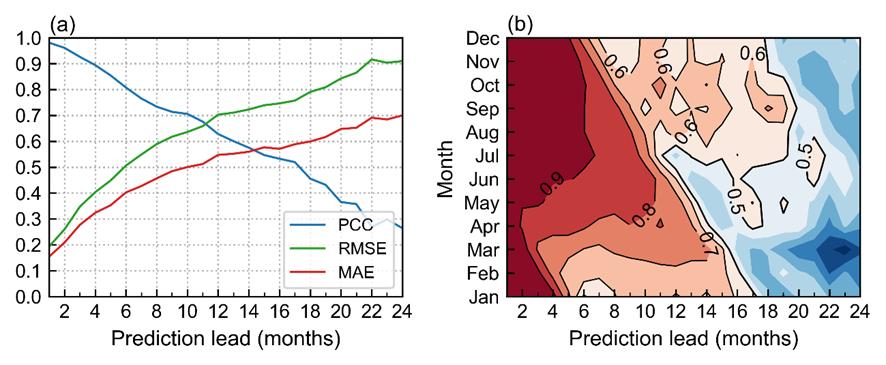Improving ENSO Predictions by Artificial Neural Network Combined with Principal Oscillation Pattern Analyses
The El Nino-Southern Oscillation (ENSO) phenomenon is the most well know and most studied interannual, or year-to-year climate phenomenon that involves ocean-atmosphere interactions. Because ENSO phases, such as a strong El Nino or La Nina can disrupt the livelihood of communities in coastal, tropical, and even mid-latitude climates, accurate and timely seasonal ENSO prediction is necessary.
Scientists who design and upgrade climate models have made significant progress researching ENSO in the last few decades. Particularly, it is now reasonable for coupled models, or models that combine atmospheric, oceanic, and ice data, to predict ENSO phase changes in advance both monthly and seasonally. However, the models' algorithms can introduce large biases and uncertainties, especially when they attempt real-time prediction. Improving this situation remains a major challenge for climate scientists to overcome.
Recently, lead author and Ph. D. student ZHOU Lu of Prof. ZHANG Ronghua's team from the Institute of Oceanology of the Chinese Academy of Sciences (IOCAS) developed a novel hybrid model, named POP-Net. This unique model combines principal oscillation pattern (POP) analyses, which are used to extract the characteristics of a changing time variable with a convolutional neural network (CNN)-long short-term memory (LSTM) algorithm. LTSM algorithms can learn the correct order of sequence-based calculation problems. Because of its ability to simplify the multivariable calculations required to predict ENSO phases, POP-Net was greatly successful at estimating the future Nino-3.4 sea surface temperature (SST) index.
The study was published in Advances in Atmospheric Sciences.
Specifically, the POP analysis method used in hybrid modeling extracts periodically propagating patterns, much like an electromagnetic wave, composed of real and imaginary parts of the POP modes from a multi-component and variable system. Based on the time and space bound properties of ENSO-related anomaly fields, most notably SST anomalies, POP analyses were first used to extract quasi-periodically propagating (wavelike) patterns from the complex climate system.
Furthermore, the hybrid POP-Net can select specific POP patterns to formulate a prediction model that may be incorporated into a data-driven model configuration, such as CNN-LSTM. This means that the hybrid model reduces how difficult it is for artificial neural network (ANNs) to automatically search for predictable information. Thus, POP-Net achieves higher ENSO prediction accuracy.
As designed, the POP-based pre-processing enhances interesting ENSO-related signals while also filtering out unrelated noise. By comparing POP-Net to its individual POP and CNN-LSTM components for ENSO predictions, POP-Net exhibits enhanced ENSO predictability. Using a 1994-2000 validation period as a baseline for the study, POP-Net's correlation coefficients exceed 0.5 with a lead time up to 17 months. Also, it is important to note that, because of this, POP-Net alleviates the spring predictability barrier (SPB).
"Regarding ENSO prediction, POP-Net's superior combined computing skill compared to the two individually configured models indicates that ANNs add significant value toward improving ENSO predictions. Process-oriented analyses feasibly enhance signal representations that may be initially faint," said ZHOU Lu.
"These preliminary results are extremely encouraging and also provide new ideas for future hybrid modeling studies that combine physical analysis methods with neural networks and deep machine learning," said Prof. ZHANG.
This research is supported by the Strategic Priority Research Program of the Chinese Academy of Sciences and the National Natural Science Foundation of China.

Fig. 1 Architecture of the POP-Net model configured for predicting the Nino-3.4 index.

Fig. 2 An assessment of POP-Net's ENSO prediction skills. (a) The all-season Pearson correlation coefficient (PCC; blue), root mean square error (RMSE; green), and mean absolute error (MAE; red). (b) The correlation coefficients between the POP-Net predicted and observed Nino-3.4 SST index as a function of lead months and start months.
Zhou, L. and R.-H. Zhang. (2022). A hybrid neural network model for ENSO prediction in combination with principal oscillation pattern analyses. Adv. Atmos. Sci.
ZHANG Ronghua
Institute of Oceanology
E-mail: rzhang@qdio.ac.cn
(Editor: ZHANG Yiyi)